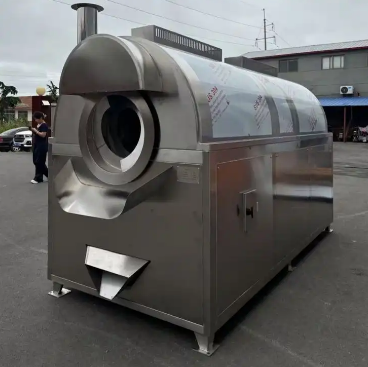<h1>The Main Components of an Electromagnetic Stir-Frying Machine</h1>Electromagnetic stir-frying machines have revolutionized the food processing industry by offering efficient, precise, and energy-saving solutions for roasting nuts, seeds, and other goods. In the B2B sector, these machines are essential for manufacturers and exporters seeking high-quality production tools. This article explores the primary components of an electromagnetic stir-frying machine, highlighting their roles, benefits, and impact on operational efficiency. Understanding these parts can help businesses make informed purchasing decisions and optimize their production lines.
The Main Components of an Electromagnetic Stir-Frying Machine
ToggleOverview of Electromagnetic Stir-Frying Machines
Electromagnetic stir-frying machines use advanced electromagnetic induction technology to generate heat directly in the cooking vessel, unlike traditional gas or electric models. This method ensures uniform heating, reduces energy waste, and minimizes the risk of hotspots that can burn products. In foreign trade, these machines are popular for their durability, ease of maintenance, and ability to handle large-scale operations. By breaking down the key components, we can appreciate how they contribute to the machine’s overall performance and reliability.
For businesses in the export market, selecting a machine with high-quality components is crucial for meeting international standards and ensuring long-term profitability. These devices are commonly used in the production of snacks, spices, and dried fruits, where precise temperature control and even stirring are vital for product consistency.
Key Components of an Electromagnetic Stir-Frying Machine
The electromagnetic stir-frying machine consists of several interconnected parts that work together to deliver efficient and safe operation. Each component plays a specific role in the heating, stirring, and monitoring processes, making the machine a versatile tool for modern food manufacturing.
Electromagnetic Heating System
The core of any electromagnetic stir-frying machine is its heating system, which relies on electromagnetic induction to produce heat. This system includes a coil that generates a magnetic field when electricity passes through it, inducing currents in the cooking pot and heating it directly.
This technology offers rapid heating and precise temperature control, often reaching desired levels in seconds. For B2B users, the efficiency translates to lower energy costs and faster production cycles, which are key advantages in competitive markets.
Additionally, the heating system is designed with safety in mind, featuring automatic shut-off mechanisms to prevent overheating. Exporters should look for systems with high-frequency inverters for better energy conversion rates, ensuring compliance with global efficiency standards.
Stirring Mechanism
The stirring mechanism ensures that food items are evenly roasted by continuously mixing them during the process. It typically includes rotating paddles or blades made from durable, food-grade materials like stainless steel.
This component is essential for preventing uneven cooking and maintaining product quality, especially for delicate items like nuts or grains. In industrial settings, adjustable speed settings allow operators to customize the stirring intensity based on the material being processed.
For foreign trade businesses, a robust stirring mechanism reduces waste and improves yield, as it minimizes the chances of burning or undercooking. Regular maintenance of this part, such as lubricating bearings, can extend the machine’s lifespan and enhance reliability in high-volume operations.
Control Panel and Interface
Modern electromagnetic stir-frying machines feature an advanced control panel that serves as the brain of the operation. This interface includes digital displays, buttons, and sometimes touchscreen technology for setting parameters like temperature, time, and stirring speed.
The control panel allows for programmable settings, enabling users to save recipes for consistent results across batches. This is particularly beneficial for B2B manufacturers who need to meet strict quality controls for export.
Incorporating user-friendly interfaces with error alerts and diagnostic tools, these panels enhance operational safety and ease of use. Businesses should prioritize models with multilingual options to cater to international markets, ensuring seamless integration into global supply chains.
Safety Features
Safety is paramount in food processing equipment, and electromagnetic stir-frying machines incorporate various features to protect operators and maintain compliance with international regulations. Key elements include automatic emergency stops, overheat sensors, and protective guards around moving parts.
These features help prevent accidents, such as fires or mechanical failures, which are critical in high-temperature environments. For exporters, machines with certified safety components can facilitate easier certification processes in regions like Europe or North America.
Moreover, built-in alarms and real-time monitoring systems provide peace of mind, allowing operators to focus on productivity. Investing in machines with robust safety integrations not only reduces liability but also boosts the machine’s market appeal in B2B trade.
Material and Construction
The construction materials of an electromagnetic stir-frying machine directly impact its durability and hygiene standards. Most machines use high-grade stainless steel for the body and cooking vessel, which resists corrosion and is easy to clean.
This choice of material ensures compliance with food safety regulations, such as those from the FDA or EU standards, making it ideal for export-oriented businesses. The robust build also withstands the rigors of industrial use, reducing downtime and maintenance costs.
Additionally, insulated housing helps in energy retention and noise reduction, contributing to a more efficient and operator-friendly workspace. When sourcing these machines, B2B buyers should verify the material quality to ensure long-term performance in diverse operational conditions.
Power Supply and Auxiliary Components
Every electromagnetic stir-frying machine requires a reliable power supply system to function optimally. This includes transformers, wiring, and sometimes backup generators to handle voltage fluctuations common in industrial settings.
Auxiliary components, such as exhaust fans for ventilation and filters to remove smoke or odors, play a supporting role in maintaining a clean processing environment. These elements are crucial for sustaining the machine’s performance and adhering to workplace safety norms.
In B2B contexts, machines with versatile power options, like compatibility with different voltages, facilitate global exports. Ensuring these components are of high quality can prevent operational disruptions and enhance the machine’s overall value.
Benefits of Understanding Machine Components for B2B Trade
Knowing the main components of an electromagnetic stir-frying machine empowers businesses in foreign trade to select, maintain, and customize equipment effectively. This knowledge can lead to better negotiations with suppliers, improved product quality, and increased competitiveness in the global market.
For instance, businesses can specify components that align with their production needs, such as enhanced stirring for larger batches or advanced controls for automation. Ultimately, this understanding fosters innovation and efficiency in food processing operations.
FAQ Section
Here are some frequently asked questions about the components of electromagnetic stir-frying machines, answered to provide clarity for B2B professionals.
What is the role of the electromagnetic heating system? The electromagnetic heating system generates heat through induction, offering precise and energy-efficient cooking compared to traditional methods.
How does the stirring mechanism affect product quality? It ensures even distribution of heat, preventing burning and maintaining consistent texture and flavor in processed goods.
Why is the control panel important for international users? It allows for easy programming and monitoring, with features like multilingual interfaces that support global operations and compliance.
What safety features should I look for in these machines? Key features include automatic shut-offs, sensors, and guards to protect against hazards, ensuring adherence to safety standards worldwide.
How do materials impact the machine’s longevity? High-quality materials like stainless steel enhance durability, resist corrosion, and facilitate easy cleaning, reducing maintenance needs over time.
Can auxiliary components be upgraded? Yes, components like power supplies and exhaust systems can often be upgraded to improve efficiency and adapt to specific operational environments.
Conclusion
In summary, the main components of an electromagnetic stir-frying machine, from the heating system to safety features, are designed to deliver efficiency, safety, and high-quality results in food processing. By understanding these elements, B2B professionals in foreign trade can make strategic decisions that enhance productivity and market competitiveness. Investing in well-constructed machines not only boosts operational performance but also supports sustainable practices, paving the way for long-term success in the global industry.









